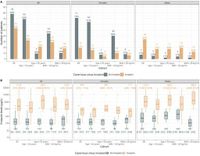Recent advancements in the treatment of prolactinomas—a type of pituitary tumor—have highlighted the significance of personalized medicine in optimizing patient outcomes. A recent study published in Scientific Reports reveals critical gender-specific prolactin (PRL) thresholds that correlate with tumor invasiveness, which may guide treatment strategies for patients suffering from this condition.
Prolactinomas present unique challenges in clinical practice, particularly in predicting long-term remission rates achieved by surgical or medical therapies. The research focused on 149 prolactinoma patients treated with either transsphenoidal surgery (TSS) or dopamine agonist (DA) therapy. The findings illuminate that elevated preoperative PRL levels strongly correlated with cavernous sinus invasion, a crucial factor affecting treatment choices.
Importantly, the study identified a cohort-wide PRL threshold of 431.9 µg/L, with gender-specific thresholds determined to be 280.8 µg/L for women and 1325.0 µg/L for men. This disparity underscores significant differences in tumor characteristics associated with gender and suggests tailored approaches for treatment. While women tended to have lower PRL thresholds, these figures remained relatively unaffected by age or body mass index, unlike those for men, whose thresholds varied significantly based on these factors.
Overall, 56 patients (37.6%) in the study exhibited cavernous sinus invasion. Of the patients studied, 87 underwent immediate surgery while 62 were treated medically. Post-surgery, 74 achieved remission without requiring ongoing DA therapy.
Exploring the background, while both DA medication and surgery are effective treatment options, physicians are increasingly concerned about the long-term reliance on DAs, particularly given the potential for adverse psychological effects such as impulse control disorders. As such, recent trends favor offering first-line surgery to younger patients, especially those with microprolactinomas or macroprolactinomas that do not invade the cavernous sinus.
The methodology employed in this research was robust, utilizing Bayesian statistical models to derive the PRL thresholds, factoring in patient demographics and treatment histories. The study’s design ensures that it builds on substantial historical data, effectively linking hormone levels to tumor invasiveness outcomes.
Findings reveal that gender-specific PRL thresholds not only enhance sensitivity and specificity when assessing invasiveness but also present an avenue for more structured clinical decision-making. Female patients consistently exhibited lower PRL thresholds across age and weight categories, suggesting that women may require lower hormone levels for better treatment outcomes.
In their discussion, the authors underscore the implications of these gender-specific thresholds, which could allow clinicians to identify patients who may benefit most from early intervention through surgical approaches rather than prolonged dopamine agonist treatment. This change represents a significant shift in clinical practice, calling for personalized treatment options that are informed by such biomarkers.
Concluding, the study emphasizes the necessity of incorporating gender-specific PRL thresholds in clinical protocols, potentially leading to improved treatment strategies for prolactinoma patients. This approach not only aims for better immediate outcomes but also strives to minimize the potential for long-term medication dependence. Future research is necessary to validate these findings and further explore the clinical benefits arising from personalized approaches to prolactinoma treatment based on hormone level monitoring.

